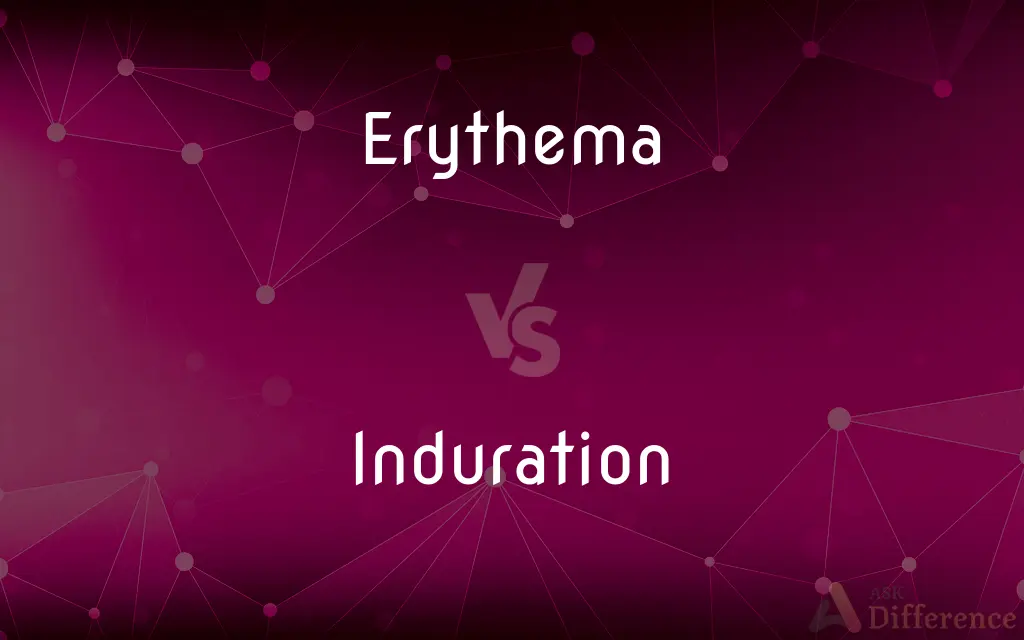Erythema vs. Induration — What's the Difference?
By Tayyaba Rehman & Fiza Rafique — Updated on April 5, 2024
Erythema is the reddening of the skin due to capillary dilation, often signaling irritation or injury, whereas induration refers to skin hardening, indicating deeper inflammation or fibrosis.

Difference Between Erythema and Induration
Table of Contents
ADVERTISEMENT
Key Differences
Erythema is primarily a visible sign of increased blood flow in superficial capillaries, usually as a response to injury or inflammation. It often presents as a red rash or patch on the skin and can be a symptom of various conditions, including infections, allergic reactions, and physical trauma. Whereas induration signifies a palpable hardness or thickening of the skin or underlying tissues, often resulting from prolonged inflammation, infection, or the accumulation of collagen and other substances. It's a physical change that suggests more serious underlying pathology, such as in the case of some chronic infections, autoimmune disorders, or even malignancies.
Erythema can vary in intensity and extent, ranging from a small, localized area affected by a minor irritant to a widespread rash indicative of a more severe systemic issue. Its appearance is usually temporary, fading as the underlying cause resolves. On the other hand, induration may develop over time and persist longer, reflecting ongoing processes that lead to tissue remodeling or damage. This distinction can be crucial for diagnosis and management.
In terms of symptoms, erythema is often associated with warmth and tenderness due to the increased blood flow, making the affected area sensitive to touch. These symptoms are superficial, affecting primarily the look and feel of the skin's surface. Induration, however, may not always be accompanied by visible changes but is characterized by a noticeable hardness on palpation, which can affect both the skin and the tissues beneath. This difference highlights the varying nature of underlying conditions and mechanisms between erythema and induration.
When evaluating erythema, healthcare providers often look for associated signs such as swelling (edema) or the presence of lesions, which can provide clues about the cause. The approach is primarily visual, supplemented by patient history. Contrastingly, the assessment of induration typically involves palpation to gauge the extent of tissue involvement and may necessitate further diagnostic tools like biopsy or imaging to understand the cause, indicating a potentially more complex diagnostic pathway.
The management of erythema focuses on addressing the underlying cause, whether it be removing an irritant, treating an infection, or managing an allergic reaction. Symptomatic treatments may also include topical corticosteroids or moisturizers. Meanwhile, managing induration often requires a more targeted approach to resolve the underlying condition, such as antibiotics for infection or immunosuppressants for autoimmune diseases, reflecting the deeper and more persistent nature of conditions associated with induration.
ADVERTISEMENT
Comparison Chart
Definition
Reddening of the skin due to capillary dilation.
Hardening or thickening of the skin or tissues.
Causes
Infections, allergic reactions, physical trauma.
Chronic inflammation, fibrosis, malignancies.
Symptoms
Redness, warmth, tenderness.
Hardness, possible lack of visible symptoms.
Diagnostic Approach
Visual inspection, patient history.
Palpation, biopsy, imaging.
Management
Address underlying cause, topical treatments.
Targeted treatment of underlying condition.
Compare with Definitions
Erythema
A common symptom in dermatitis, presenting as a red rash.
The patient's erythema worsened after contact with the allergen.
Induration
A physical change indicating deeper tissue involvement.
Induration around the wound suggested a deeper infection.
Erythema
May occur as a reaction to sun exposure, known as sunburn.
Prolonged sun exposure resulted in erythema on her shoulders.
Induration
Commonly assessed by palpation during physical examination.
The doctor noted induration in the lymph node during examination.
Erythema
Can signal an infection when accompanied by fever.
The erythema on his leg was warm to touch, suggesting an underlying infection.
Induration
Hardening of the skin often due to underlying fibrosis.
The induration on her forearm felt like a thickened patch.
Erythema
Redness of the skin caused by increased blood flow.
Erythema appeared around the wound site, indicating inflammation.
Induration
May develop in chronic inflammatory conditions.
Years of eczema led to induration of the skin on his elbow.
Erythema
Often a sign of skin irritation from external irritants.
The cosmetic product caused erythema and itching.
Induration
Reflects a more severe or chronic condition than erythema.
Unlike the transient erythema, the induration hinted at a lasting issue.
Erythema
Redness of the skin caused by dilatation and congestion of the capillaries, often a sign of inflammation or infection.
Induration
The quality or condition of being hardened.
Erythema
Abnormal redness and inflammation of the skin, due to vasodilation.
Induration
The act or process of becoming hardened.
Erythema
Skin redness from sunburn or chemical irritation
Induration
Hardness.
Erythema
A disease of the skin, in which a diffused inflammation forms rose-colored patches of variable size.
Induration
Process of becoming hard.
Induration
(medical) Hardening of an area of the body as a reaction to inflammation, hyperemia, or neoplastic infiltration.
Induration
(medical) An area or part of the body that has undergone such a reaction. Most often this term is used to describe dermatologic findings.
Induration
(geology) The quality of non-friability; the extent to which a rock does not crumble; rock strength.
Induration
(geology) The process of the strengthening of rocks by heating, compaction or cementation, or a combination thereof.
Induration
The act of hardening, or the process of growing hard.
Induration
State of being indurated, or of having become hard.
Induration
Hardness of character, manner, sensibility, etc.; obduracy; stiffness; lack of pliancy or feeling.
A certain induration of character had arisen from long habits of business.
Induration
Any pathological hardening or thickening of tissue
Common Curiosities
What is erythema?
Erythema is the reddening of the skin caused by increased blood flow to the capillaries, often in response to injury or irritation.
What causes induration?
Possible causes include prolonged inflammation, infections, autoimmune disorders, and the accumulation of collagen or other substances in tissues.
Is erythema a sign of infection?
It can be, especially if accompanied by symptoms like warmth, swelling, or fever, indicating an inflammatory response to infection.
What does induration mean?
Induration refers to the hardening or thickening of the skin or underlying tissues, often due to chronic inflammation, fibrosis, or other pathological processes.
How is induration diagnosed?
It often requires palpation to assess hardness and may need further diagnostic tools like biopsy or imaging to determine the underlying cause.
What causes erythema?
Causes include infections, allergic reactions, physical trauma, and exposure to certain substances or environmental factors.
How is erythema diagnosed?
Diagnosis primarily involves visual inspection and assessing patient history to identify potential causes and associated symptoms.
Can erythema and induration occur together?
Yes, they can coexist, especially in conditions that involve both superficial and deeper tissue inflammation or damage.
How are erythema and induration treated?
Treatment focuses on addressing the underlying cause, with erythema often managed through removal of irritants and topical treatments, while induration may require more specific interventions.
Is induration always serious?
While not always serious, induration can indicate more severe or chronic conditions that require further evaluation and treatment.
Share Your Discovery

Previous Comparison
Philadelphia vs. Pennsylvania
Next Comparison
Advantage vs. EdgeAuthor Spotlight
Written by
Tayyaba RehmanTayyaba Rehman is a distinguished writer, currently serving as a primary contributor to askdifference.com. As a researcher in semantics and etymology, Tayyaba's passion for the complexity of languages and their distinctions has found a perfect home on the platform. Tayyaba delves into the intricacies of language, distinguishing between commonly confused words and phrases, thereby providing clarity for readers worldwide.
Co-written by
Fiza RafiqueFiza Rafique is a skilled content writer at AskDifference.com, where she meticulously refines and enhances written pieces. Drawing from her vast editorial expertise, Fiza ensures clarity, accuracy, and precision in every article. Passionate about language, she continually seeks to elevate the quality of content for readers worldwide.















































